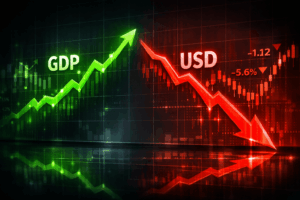Daily News Nuggets | Today’s top stories for gold and silver investors
November 10th, 2025
Democrats Blink After 40-Day Standoff
After holding the line for weeks, eight Senate Democrats broke ranks Sunday night to advance a deal that would reopen the government — barely clearing the 60-vote threshold needed to move forward. The agreement funds the government through January 30 and provides full-year funding for veterans programs, agriculture, and legislative operations.
What Democrats didn’t get: a guaranteed extension of Affordable Care Act subsidies expiring in December. Instead, they settled for a promise of a vote by mid-December — essentially the same offer Republicans made six weeks ago. Progressive Democrats are furious, calling it “capitulation,” but moderates felt the pain was too much: 750,000 furloughed workers, more than 2,000 flight cancellations Sunday alone, and SNAP benefits hanging in the balance for 42 million Americans.
The deal now heads to a full Senate vote, then the House, before hitting Trump’s desk. Markets may breathe easier with the immediate crisis defused, but January’s just around the corner — and the bigger fiscal fights haven’t gone anywhere.
Gold Blazes Past $4,000 as Washington Dysfunction Adds Fuel
Gold surged 2.2% Monday to around $4,080 an ounce, while silver jumped 3.1%, with the shutdown breakthrough paradoxically reinforcing precious metals’ appeal. While the deal restores critical Fed data flows, it also reminds investors that political dysfunction remains the norm—not the exception.
The metal has retreated about 6% from its October peak above $4,380, but it’s still up more than 50% this year — far outpacing the S&P 500’s 15% gain. What’s driving it? A toxic mix of political chaos, a souring job market, and near-record-low consumer sentiment. China’s central bank added gold for the 12th straight month in October, and analysts at UBS think prices could hit $4,200 in the coming months.
The real story: gold isn’t rallying despite uncertainty being resolved — it’s rallying because investors know more is coming.
Investors Can’t Get Enough Gold — Literally
The World Gold Council’s Q3 report confirms what the price action already showed: investment demand for gold went parabolic. Bar and coin purchases hit their strongest quarterly level in nearly 15 years, while gold ETFs logged robust inflows across the board. The drivers? Fed independence fears, dollar weakness, the government shutdown, and good old-fashioned FOMO as prices kept breaking records.
Central banks continued their three-year buying spree, adding 630 tons year-to-date—still a historically strong pace. Meanwhile, jewelry demand cratered in India and China as sky-high prices forced consumers to buy lighter pieces or skip gold entirely. Some Indian holders are now pledging their jewelry as collateral for loans rather than selling, trying to capture gold’s appreciation without parting with it.
Why the Dollar Still Runs the Commodity Show
Nearly every major commodity — oil, copper, gold — is priced in dollars, creating an inverse relationship that dictates fortunes across global markets. When the greenback strengthens, commodities get pricier for foreign buyers, dampening demand. When it weakens, they rally.
The Fed’s every move matters here. Rate hikes attract global capital and strengthen the dollar; cuts do the reverse. Algorithmic trading amplifies the swings, triggering instant reactions across energy, metals, and agriculture. Mining giants like Rio Tinto and BHP get squeezed when the dollar is strong — they earn in dollars but pay local-currency costs.
Gold’s 50%-plus rally this year? Turbo-charged by dollar weakness and Fed uncertainty. In a world where Treasury yields reflect fiscal anxiety instead of strength, gold’s role as the anti-dollar hedge has never been more relevant.
America’s Job Engine Is Sputtering — And Nobody Knows How Bad It Really Is
With official labor data blocked by the shutdown, private reports are filling the void — and they’re not encouraging. ADP says private employers added just 42,000 jobs in October, while Challenger Gray reported over 153,000 layoffs that month, the worst October since 2003. Year-to-date layoffs have hit 1.1 million, up 44% from all of 2024.
The culprits: cost-cutting, AI automation, and unwinding pandemic-era hiring sprees. Consumer sentiment just crashed to 50.3—a three-year low—as Americans worry about both the shutdown and their job security. “If you have a job, great,” says economist Betsey Stevenson. “But if you lose it, you’re in more trouble than you would have been a year ago.”
The Fed’s flying blind without official data, but traders are betting 70% odds on a December rate cut anyway. That’s the bet on gold in a nutshell: when uncertainty is the only certainty, hard assets win.






